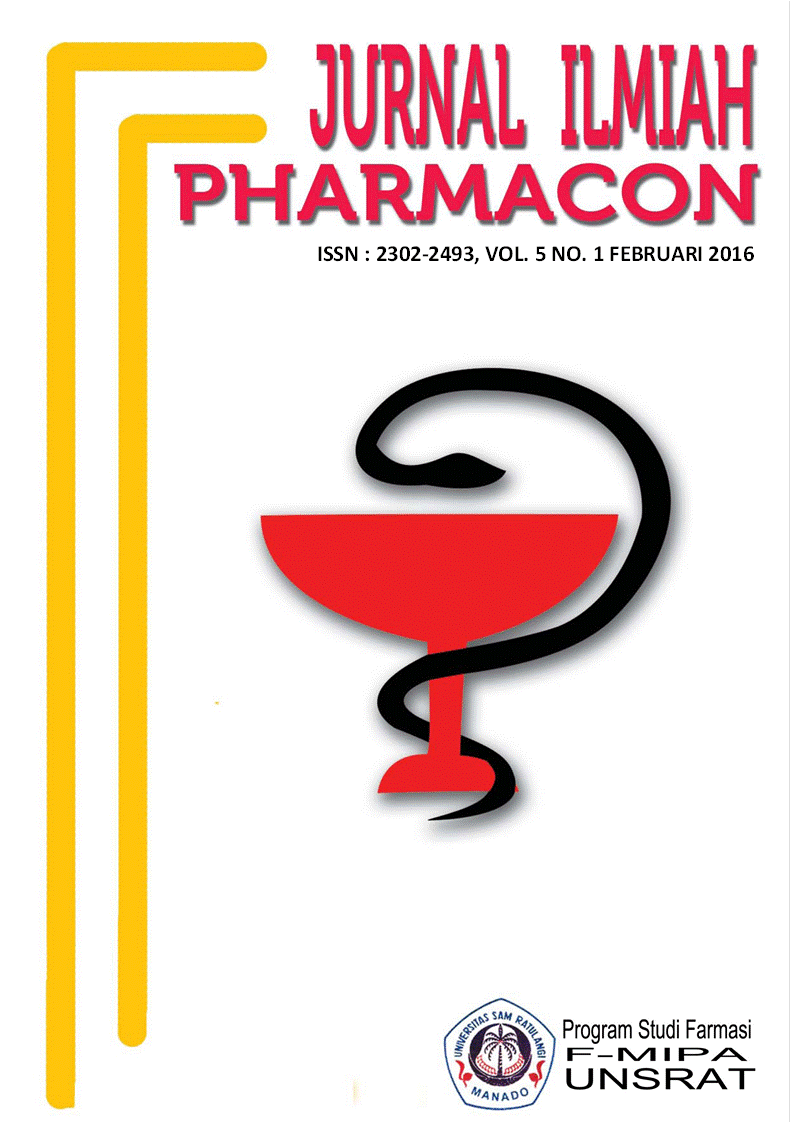PERBEDAAN JUMLAH PERTUMBUHAN KOLONI BAKTERI RONGGA MULUT SEBELUM DAN SESUDAH MENGGUNAKAN OBAT KUMUR YANG MENGANDUNG CHLORHEKSIDINE
DOI:
https://doi.org/10.35799/pha.5.2016.11220Abstract
PERBEDAAN JUMLAH PERTUMBUHAN KOLONI BAKTERI RONGGA MULUT SEBELUM DAN SESUDAH MENGGUNAKAN OBAT KUMUR YANG MENGANDUNG CHLORHEKSIDINE
Widya A.Patabang1), Michael A.Leman1), Jimmy Maryono1)
1)Program Studi Pendidikan Dokter Gigi Fakultas Kedokteran
Â
ABSTRACT
Mouthwashes often used for daily plaque control, especially for individuals with poor oral clearance. Rinsing with mouthwash can eliminate bacteria in the oral cavity between teeth that are not reached by the toothbrush. Chlorheksidine, a kind of antiseptic used by many health experts as a good dental cleaning and dental disease treatment drugs. Chlorheksidine also grouped into two groups: chlorheksidine nonalcoholic and alcoholic chlorheksidine. The purpose of this study to determine differences in the number of bacterial colonies growing oral cavity before and after using mouthwash containing chlorheksidine. This study is a quasi-experimental research (quasi experiment) with pretest and postest study design controlled group that carried out in the Laboratory of Microbiology, Faculty of Medicine Unsrat with a sample of 10 people. Criteria for inclusion in this study are 20-25 years old, with good oral clearens, and willing to participate in research. Exclusion criteria in this study is taking drugs orally or systemic antibiotics, using braces and there are lesions in the oral cavity.The average value before rinsing with chlorheksidine that 105CFU/mL, and after gargling with chlorheksidine that 101CFU/mL with the differences 104CFU/mL. Conclusion :The results showed that a decline in growth in the number of colonies of bacteria of the oral cavity after rinsing with mouthwash which containing chlorheksidine.
Key words :mouthwashes, colonies of bacteria, chlorheksidine
Â
Â
ABSTRAK
Obat kumur sering digunakan untuk kontrol plak sehari-hari, khususnya bagi individu dengan kebersihan mulut yang buruk. Berkumur dengan obat kumur dapat menghilangkan bakteri rongga mulut di cela-cela gigi yang tidak terjangkau oleh sikat gigi. Chlorheksidine jenis antiseptik yang banyak digunakan oleh para ahli kesehatan gigi baik sebagai pembersih dan obat pengobatan penyakit gigi. Chlorheksidine dikelompokkan menjadi dua kelompok yaitu chlorheksidine tanpa alkohol dan chlorheksidine beralkohol. Tujuan penelitian ini untuk mengetahui perbedaan jumlah pertumbuhan koloni bakteri rongga mulut sebelum dan sesudah menggunakan obat kumur yang mengandung chlorheksidine.Penelitian ini merupakan penelitian eksperimental semu (quasi eksperiment) dengan rancangan penelitian pretest dan postestcontrolled grup yang dilaksanakan di Laboratorium Mikrobiologi Fakultas Kedokteran Unsrat dengan sampel sebanyak 10 orang. Kriteria inklusi dalam penelitian ini yaitu berusia 20-25 tahun, kebersihan mulut yang baik, dan bersedia berpartisipasi dalam penelitian. Kriteria ekslusi dalam penelitian ini yaitu mengonsumsi obat-obatan oral maupun antibiotik sistemik, menggunakan kawat gigi dan terdapat lesi dalam rongga mulut. Hasil penelitian menunjukkan nilai rata-rata sebelum berkumur dengan chlorheksidine yaitu 105CFU/mL dan sesudah berkumur dengan chlorheksidine yaitu 101CFU/mL dengan nilai selisih 104CFU/mL. Kesimpulan Penurunan pertumbuhan jumlah koloni bakteri rongga mulut sesudah berkumur dengan obat kumur yang mengandung chlorheksidine.
Â
Kata kunci : obat kumur, koloni bakteri, chlorheksidine
Â
Downloads
Published
How to Cite
Issue
Section
License
Authors who publish with this journal agree to the following terms:
- Authors retain copyright and grant the journal right of first publication with the work simultaneously licensed under a Creative Commons Attribution-NonCommercial 4.0 International License that allows others to share the work with an acknowledgement of the work's authorship and initial publication in this journal.
- Authors are permitted and encouraged to post their work online (e.g., in institutional repositories or on their website) prior to and during the submission process, as it can lead to productive exchanges, as well as earlier and greater citation of published work (See The Effect of Open Access)










